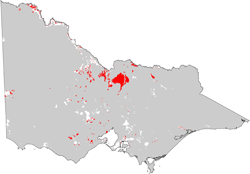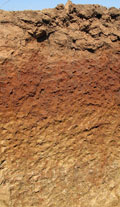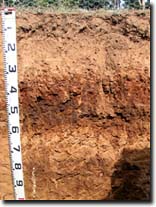Victorian Horticulture Soils - Sodosols
Back to: Victorian Horticulture Soils
Sodosols have strong texture contrast between sandy to clay loamy surface (A) horizons and dense and coarsely structured clayey subsoil (B) horizons that are sodic (i.e. exchangeable sodium percentage is 6 or greater) and not strongly acid (i.e. pH 5.5 is or greater).
Using the Australian Soil Classification, Sodosols can be separated on the basis of the colour of the upper 20 cm of the subsoil into Red, Brown, Yellow, Grey and Black Groups. Further separations within these Suborders are made largely on the basis of key chemical characteristics in the subsoil (e.g., degree of sodicity, presence of calcium carbonate).
Distribution
| Red Sodosols (previously referred to as ‘red-brown earths’) are most commonly used for horticulture and occur extensively on the older alluvial plains that occupy much of the northern Riverine Plain region of Victoria. They are characterised by upper subsoils that are red in colour and sodic, often with visible calcium carbonate (‘lime) in the deeper subsoil. In some areas (where prior streams were active) there is a textural sequence, from soils with a higher proportion of sand on prior stream levees to more clay rich soils on the floodplains. The lighter surface soils generally have higher productivity, both under dryland and irrigated farming. The heavier soils are more affected by hard-setting surfaces and lower hydraulic conductivity. In this region, the lower sites in the landscape often have Grey Vertosols. Red Sodosols, similar to the northern plains, also occur in the Werribee irrigation region. The surface soils are mainly between 20 - 35 cm deep and are generally friable brown to greyish brown silty to fine sandy clay loams and fine sandy loams which are slightly acid. When dry, the soils are hardsetting. The subsoils are generally dark brown, dark reddish brown, or dark greyish brown medium clays which are mainly sodic. With depth the soils usually become lighter textured and paler and greyer in colour, often with yellowish grey and yellowish brown mottles and are invariably moderately to very strongly alkaline. Soft calcium carbonate ('lime') concretions generally occur beyond 80 cm depth. Soil pit site PPW4 is an example of a Red Sodosol near Werribee. |  |
 Image of a red sodosol near Shepparton |  Red Sodosol at Werribee |
Management Considerations
Management strategies for all soils should include: increasing organic matter levels in the surface soil, minimising the degradation of soil aggregates and porosity, promoting the development of stable biopores, improving the calcium status of the cation exchange complex (particularly when sodium is a significant part), and breaking up any hardpans. Less frequent tillage, using less aggressive implements and working the soil at its optimum moisture content, can all assist in maintaining soil aggregation and porosity, as well as reducing the breakdown of organic matter.
Sodic soils are more suited to horticulture if the surface horizon is relatively deep (i.e. deeper than 30 cm), reasonably friable, and does not have large amounts of ferruginous gravel ('buckshot'). This also depends on the nature of the upper subsoil horizon, with less dense and better structured subsoils allowing for more effective root and water movement into the subsoil. A number of management strategies can be considered for Sodosols that include raised beds and improving soil drainage. Red Sodosols are most commonly used for horticulture and are generally better drained than their grey and yellow mottled counterparts.
Surface (A) horizons
Sodic soils often exhibit poor soil surface structure that can result in poor plant emergence, waterlogging and ponding, and are often difficult to work when too wet or dry. Surface soil aggregates are often unstable and slake when wet. When dry, the surface soil sets hard and become difficult to work. Some surface soils also disperse and seal when wet and become hardsetting and crusty when dry. Surface sealing reduces crop emergence and restricts entry of water into the soil, which can result in reduced crop yields. Raindrop action could also have a deleterious effect on bare surface soil. Reduced cultivation and/or stubble retention assists formation of aggregates by maintaining higher organic matter levels and protecting the soil from rain drop impact. Gypsum also has an ameliorative effect on soil sodicity and resultant dispersion.
Often surface and/or subsurface horizons can disperse strongly after remoulding. This indicates that they may disperse if excessively cultivated or overstocked when wet (particularly when the soil is wetter than the ‘plastic limit’) which can degrade soil structure and increase compaction. Ideally, tillage and trafficking should take place when the soil is drier than the plastic limit, down to at least the tillage depth.
The moisture range at which these soils can be easily worked without causing structural degradation is very narrow. For much of the year the soil is either too wet or too dry to cultivate. Gypsum can help improve this situation. Crop establishment can become difficult if heavy rain falls after sowing but before emergence, causing surface sealing and compaction which restricts crop emergence or causes un-germinated seed to rot. When cultivated dry, the surface soil can become ‘powdery’ and more readily erodible by wind. Timing cultivation at the correct soil moisture and reducing frequency and speed of working can reduce soil structural damage. Frequent cultivation on hardsetting Sodosols can have a deleterious effect on soil structure, increasing erodibility, compaction, or resulting in aggregate breakdown. Reduced cultivation and residue retention have been shown to improve soil structure and result in improved water infiltration and more favourable seedbed conditions.
Subsoil (B) horizons
Sodosols often have dense and coarsely structured subsoils that are sodic and usually disperse strongly in water. This results in restricted root, water and gas movement through the profile. The consequent lack of oxygen in the root zone will deleteriously affect the crop. During hot weather, there may also be excessive evaporation due to the restriction of drainage through the profile. On sloping land, lateral water movement may occur above the relatively impermeable subsoil horizon.
The presence of bleached subsurface (A2) horizon above the sodic subsoil indicates that water movement is restricted and that waterlogging can occur in wet seasons. Bleached subsurface horizons often become “spewy” and tractor bogging potential can be high in winter. Lighter-textured (i.e. sandy) surface soils, where present, allow plants to respond to lower rainfall events. Surface soil structure is often weak and pugging can be an issue in winter and spring. Bleached subsurface horizons often become “spewy” and tractor bogging potential can be high in winter.
When wet, dispersive soils have very little strength and are therefore more readily prone to gullying and tunnel erosion. Sodic clay subsoils (particularly on sloping land) can pose an erosion risk if exposed, or if the surface soil has been removed.
It is common for Sodosols in northern Victoria (and some developed on basalts in the South West) to be slightly acid in the surface soil but become strongly alkaline with depth. The level of soluble salts (salinity) can also increase significantly in the deeper subsoil.


